________________
300
adhered to their mendicant vows [for they were able to obtain proper food], returned to the Middle Country (Madhya-desa, i.e., Avanti). But the other three groups (led by Ramilla and so forth), who had gone to the country of Sindhu, were unable to obtain food or water during that severe drought. Upon returning [to Avanti?] they reported the following [in Ujjayini?]:1
(iv) vv. 49-53: At that time of terrible drought, when there was neither food nor water, people gathered at the doors of houses and made a lot of noise. Because of this, the householders could not eat their food. They remained hungry during the day and started eating only at night (to avoid the crowd outside). [There laypeople said to us] 'You, sirs, for fear of the people [outside], please obtain begging bowls (patras) from our houses [and collect food going from door to door] during the night and eat the gathered alms during the day inside the residence of your host layman (sva-śrävaka-gṛhe). Thus abiding by the wishes of the people, our acaryas and other mendicants fed themselves accordingly, 13
COLLECTED PAPERS ON JAINA STUDIES
(v) vv. 54-60: One night a certain emaciated monk visited a Jaina household with his bowl in hand, and the sight of that naked (nirgrantha) monk caused such a fright to a young pregnant woman that she aborted the fetus. Seeing that, the Jaina. laymen approached the heads of the monks and said, 'O sages! This is a time of calamity. When the good times arrive, you may, having undertaken the appropriate expiations (prayaścitta), abide again by the rules of mendicancy. Therefore, for the duration of this period, you should [visit the households] at night covering yourself with half-a-piece of cloth (ardhaphalaka) held on your left arm and holding the begging bowl in your right hand, and cat the food [thus collected] during the daytime.' Hearing these assuring words of the laypeople, the monks acted accordingly.1
(vi) vv. 61-68: Time passed and there soon arrived conditions of prosperity and people became happy, freed from the state of misery. Then the three acaryas consulted with each other and addressed their communities of monks: 'O monks, with your minds happy, abandon now your half-a-piece of cloth (ardhaphalaka), and for the sake of emancipation (moksa), resort to the excellent vow of nudity (nirgranthata).' Hearing those words, some monks resumed the vow of nudity. The three acaryas, namely, Ramilla, Sthavira and Sthulabhadra, also approached the venerable
301
JAINA MONKS FROM MATHURA
Visakhācārya and abandoning the half-a-piece of cloth. (ardhakarpata) assumed anew the vow of nudity. But certain others, the cowardly weaklings, ignorant of the highest good, who did not like the advice of the teachers, formed this order (firtha) called the Ardhaphalaka, and [thus] created a twofold mendicant order: the Jina-kalpa and the Sthavira-kalpa.16
(vii) vv. 69-79: In the country of Saurashtra, in the city of Valabhi, there ruled a heretic (i.e. a non-Jaina) king named Vapravada (Vaprapala in the Vadḍaradhane). But his chief queen Svämini became a great devotee of these Ardhaphalaka ascetics. One day a group of these monks arrived at the palace of this king at midday to collect alms. Seeing them the king became curious and said to the queen, 'O Lady! Your group of Ardhaphalaka monks is no good; they are neither clad nor naked; it is ridiculous (saviḍambana). On another day, when a group of Ardhaphalaka monks entered the city, the king said to them, 'You should abandon this half-a-piece of cloth and assume nudity [as is proper].' They did not desire that, and the king, even more astonished, said, 'O ascetics, if indeed you are unable to assume the form of nudity, then give up this half-a-piece of cloth, the cause of your ridicule, and attire yourselves in proper clothes and reside happily here in my kingdom."
(viii) vv. 80-81: From that day onward, by the order of the king Vapravada, in the country of Lata (Gujarat), there came into being the Kambala-tirtha (the sect of monks who use a blanket?) [Vaddärädhane, 93: Those who were of the Kambalatirtha came to be called Sveta-pata (=the Svetämbara)]. From that Kambalika-tirtha, in the Săvalipattana, was born the Yapanasangha in the Southern Country." [Vaddärädhane, 93: In the Daksinäpatha, King Samaliputta became the leader of the Svetabhiksu Jäpuli-samgha, which descended from the Sveta-patas.]
Since this is a Digambara account of the origins of their opponents the Svetämbaras and since there is no Svetämbara counterpart to any of these stories, it may not serve as a totally reliable document. However, after a careful examination of the ardhaphalaka monks as depicted in the Mathura sculptures, I believe that the Bhadrabahu kathanaka may indeed contain a kernel of truth. The narrative is primarily talking about what one may call an apavada-veša, a temporary measure appropriate to a




